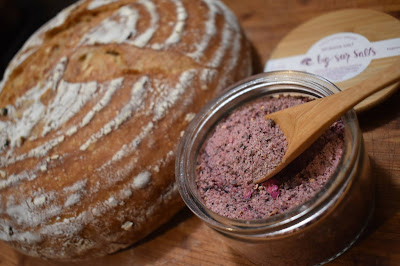If you read my blog regularly, you'll know that this shelter-in-place order inspired me to buckle down and actually learn how to make sourdough bread. You can learn more about that in my Dough-Ba Fett's Sourdough Adventures tab, but basically, I baked a bunch of doorstoppers, then I started to get the hang of it, then I went off the deep end with variations and had to go back to the basics. And, now, after coming up with my standard loaf - Ten-Percent Rye Sourdough Boules - I am easing back into small changes. My biggest variations have come with using craft salts from Big Sur Salts. Carlo Overhulser is a local-to-me salt artisan who sources his salt from Big Sur pools and blends them with hyper-local ingredients. I have several on my counter at the moment, but it was his Morada Salt that inspired this set of boules.
The Morada Salt blend include elderberry syrup wild salt from another local purveyor - Carmel Berry Co. -, Pico Blanco sea
salt, hibiscus, rose bud, and lemon zest. The aroma is fantastic, the flavor amazing, but it was the color that originally drew me to it. I love pink! I think it has to do with being a permanent resident of Testosterone Land with Jake and our two teenaged boys. So, I decided to use the salt blend in a loaf and added in some dried elderberries to go along with that theme.
Ingredients makes 2 loaves
- 200 grams sourdough starter (recently fed)
- 600 grams warm water + 50 grams warm water
- 900 grams all-purpose flour + more as needed
- 100 grams rye flour
- 20 grams salt (I used Big Sur Salts' Morada Salt)
- 1/4 cup dried elderberries
- rice flour for sprinkling in Dutch oven
- Also needed: banneton proofing baskets or bowls lined with floured tea towels, Dutch ovens
Procedure
At the end of 40 minutes, pour in another 50 grams of warm water. Add in the 20 grams of salt and gently knead the dough until the water is completely absorbed.
Now I start the folds: rotating 90 degrees four times every thirty minutes for 4 hours.
I run my hand under warm water, grab one side of the dough and pull from underneath, folding it over the top of the ball. Rotate the bowl 90 degrees and repeat. Rotate. Repeat. And a fourth time so that the bowl has completed a full circle.
Before your second folds, add in the dried elderberries so that
they will be incorporated throughout the dough. I sprinkled 1 Tablespoon on top, then did one fold. Sprinkled another 1 Tablespoon, then did a
second. The third and fourth folds used the rest.
Repeat this process of four rotating folds plus a half hour
rest for four hours. After four hours, the dough will be smooth and billowy.
Lightly flour a workspace and use a dough scraper to divide the dough ball in half. Transfer the dough balls to the work surface. Lightly flour the banneton or towel-lined bowl. I used a combination of all-purpose and rye for these boules.
Now I repeat the folds, but with dry hands to shape the boules while creating tension in the top. Or, my lovely kitchen assistant does it so I can take photos of the process.
Keep the floured side of the ball down and fold from top to bottom four times while rotating the dough. This keeps the sticky side inside.
Flip the ball over and work the dough into a tight round. Let stand for 15 minutes. Repeat three times.
Preheat the oven to 500 degrees Fahrenheit. Place the empty Dutch ovens (bottoms only) into the oven. When the oven reaches temperature - an in-oven thermometer is very, very helpful - let the oven stay at 500 degrees for 30 to 40 minutes.
After the preheating, remove the Dutch ovens and reduce the oven temperature to 450 degrees F. Lightly flour the inside of the ovens with a sprinkling of rice flour. Gently pull the dough away from the sides of the banneton and invert into the Dutch oven.
Score the top with a knife or razor blades. Place the lid on the Dutch oven and return the pots carefully to the hot oven. Bake for 40 minutes.
After 40 minutes, carefully remove the lid and return the pots to the oven again. Bake for an additional 35 minutes.
The loaves should be firm and crunchy on the top, golden brown, and feel hollow when the bottom is tapped. Move the loaves to a wire rack and let cool for at least an hour before slicing! Enjoy.







Comments
Post a Comment